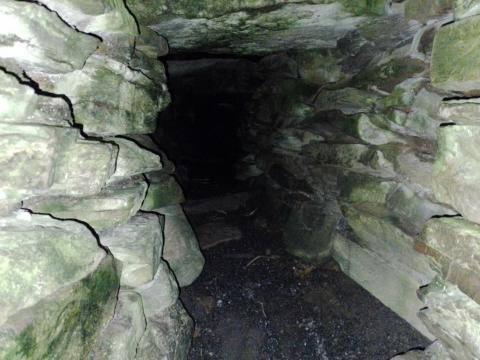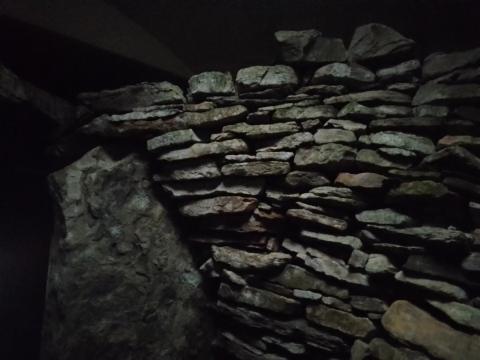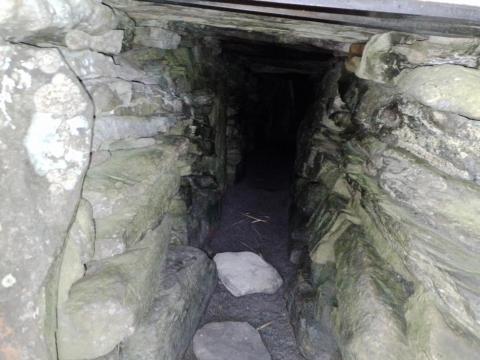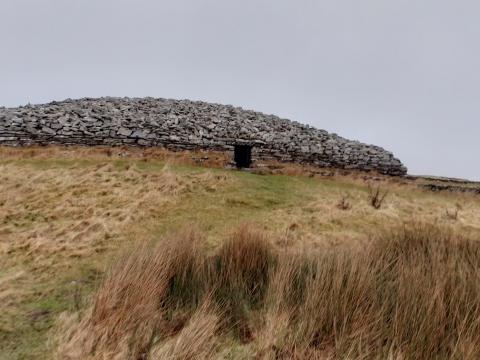Camster Cairns

There are times in my life when I ask myself “What on earth are you doing here?”. Yesterday was one of them. I was on my hands and knees, crawling. My destination was ahead, but it was unseen, its distance unmeasured. I began torturing myself with thoughts of having to crawl out backwards, or getting stuck, or the passageway collapsing in on itself. The ground was damp and dirty, the tunnel barely wide enough to admit my girth. My only consolation was hearing the hail and rain battering the ground outside, while inside was silent and still. Where I was going might be dark and cold, but it would be relatively dry. The passage grew narrower before widening, till eventually I arrived at my destination and was able to stand upright.
I was climbing inside a four-thousand-year-old cairn in Caithness, not far from Thurso and John O’Groats. There were several cairns on the site, though I elected to enter only two; a third entrance provoked feelings of claustrophobia too great to ignore. I consoled myself that once I had seen the inside of two ancient cairns, I had seen the inside of them all. The round cairn and the long cairn are both in superb condition.

As usual, no one knows why they were constructed. They might have been living quarters, but their low, small entrances certainly suggest dangerous times if so. Rodney Castleden in Neolithic Britain notes evidence of dead bodies left there, sitting upright, but with their legs missing. I suspect they were constructed as charnel houses, where dead bodies were stored, away from carrion seeking predators and the Highland elements. Certainly, they were built by the descendants of Japheth, and probably while he was still alive (after all, his brother Shem coexisted with Abraham, who postdates these constructions). I therefore think that the builders and first occupants understood more about Noah and the early chapters of Genesis than their modern-day progenies who dismiss as myth that which they cannot comprehend.

As I crawled inside those ancient tombs I felt myself nearer death. A little light was admitted from the roof but otherwise, all was dark and cold. Whatever the identity of those ancient builders and the reason for their endeavour, death we have in common. They died, as we die; they bury their dead as we dispose of ours. Thank God, we have a redeemer, Christ Jesus, who conquered death and the cold, dark grave. Those builders might have remembered Father Japheth’s recollection of Noah’s talk of a deliverer; they might have had a better understanding of redemption than many modern Scots who have abandoned their great Christian heritage. Most humans end up in those dark chambers of hades, awaiting the judgement of the God whose redemption they neglected or spurned.

Let Job, the builders' contemporary, have the final words:
That they were graven with an iron pen and lead in the rock for ever! For I know that my redeemer liveth, and that he shall stand at the latter day upon the earth:And though after my skin worms destroy this body, yet in my flesh shall I see God. 19:24-26

Uprising from the darksome tomb,
See the victorious Jesus come;
The Almighty Prisoner quits the prison,
And angels tell, The Lord is risen.
Ye guilty souls, that groan and grieve,
Hear the glad tidings, hear and live!
God’s righteous law is satisfied,
And justice now is on your side.
Your Surety, thus released by God,
Pleads the rich ransom of his blood;
No new demand, no bar remains,
But mercy now triumphant reigns.
Believers, hail your rising Head,
The first-begotten from the dead;
Your resurrection’s sure, through his,
To endless life and boundless bliss!
-Joseph Hart, Gadby's Hymns, No 488
- Log in to post comments


 Sunday Worship 10.45am & 6.00pm
Sunday Worship 10.45am & 6.00pm